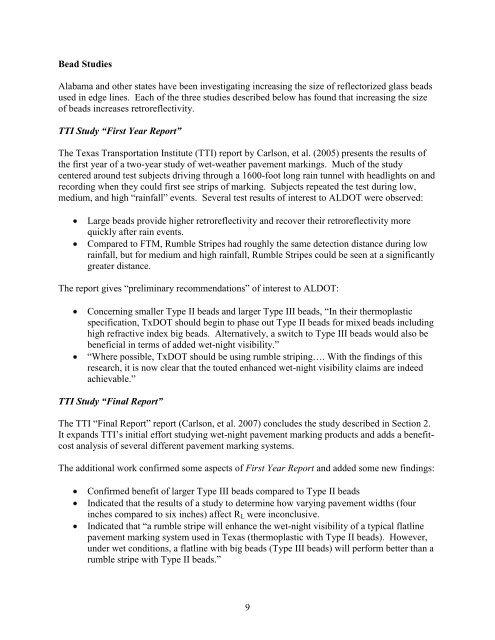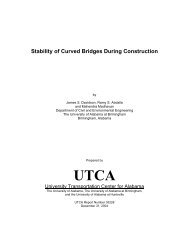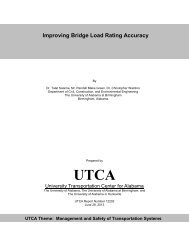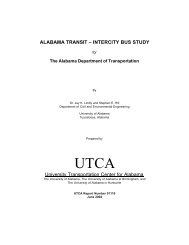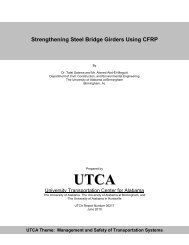Evaluation of Double Drop Beads Pavement Edge Lines - University ...
Evaluation of Double Drop Beads Pavement Edge Lines - University ...
Evaluation of Double Drop Beads Pavement Edge Lines - University ...
Create successful ePaper yourself
Turn your PDF publications into a flip-book with our unique Google optimized e-Paper software.
Bead StudiesAlabama and other states have been investigating increasing the size <strong>of</strong> reflectorized glass beadsused in edge lines. Each <strong>of</strong> the three studies described below has found that increasing the size<strong>of</strong> beads increases retroreflectivity.TTI Study “First Year Report”The Texas Transportation Institute (TTI) report by Carlson, et al. (2005) presents the results <strong>of</strong>the first year <strong>of</strong> a two-year study <strong>of</strong> wet-weather pavement markings. Much <strong>of</strong> the studycentered around test subjects driving through a 1600-foot long rain tunnel with headlights on andrecording when they could first see strips <strong>of</strong> marking. Subjects repeated the test during low,medium, and high “rainfall” events. Several test results <strong>of</strong> interest to ALDOT were observed:Large beads provide higher retroreflectivity and recover their retroreflectivity morequickly after rain events.Compared to FTM, Rumble Stripes had roughly the same detection distance during lowrainfall, but for medium and high rainfall, Rumble Stripes could be seen at a significantlygreater distance.The report gives “preliminary recommendations” <strong>of</strong> interest to ALDOT:Concerning smaller Type II beads and larger Type III beads, “In their thermoplasticspecification, TxDOT should begin to phase out Type II beads for mixed beads includinghigh refractive index big beads. Alternatively, a switch to Type III beads would also bebeneficial in terms <strong>of</strong> added wet-night visibility.”“Where possible, TxDOT should be using rumble striping…. With the findings <strong>of</strong> thisresearch, it is now clear that the touted enhanced wet-night visibility claims are indeedachievable.”TTI Study “Final Report”The TTI “Final Report” report (Carlson, et al. 2007) concludes the study described in Section 2.It expands TTI’s initial effort studying wet-night pavement marking products and adds a benefitcostanalysis <strong>of</strong> several different pavement marking systems.The additional work confirmed some aspects <strong>of</strong> First Year Report and added some new findings:Confirmed benefit <strong>of</strong> larger Type III beads compared to Type II beadsIndicated that the results <strong>of</strong> a study to determine how varying pavement widths (fourinches compared to six inches) affect R L were inconclusive.Indicated that “a rumble stripe will enhance the wet-night visibility <strong>of</strong> a typical flatlinepavement marking system used in Texas (thermoplastic with Type II beads). However,under wet conditions, a flatline with big beads (Type III beads) will perform better than arumble stripe with Type II beads.”9


